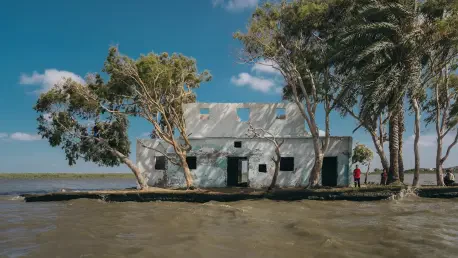Across the United States, a troubling trend is unfolding as countless homeowners, particularly in regions like New Jersey, New York, and Connecticut, find themselves stripped of home insurance coverage due to escalating weather-related dangers. This crisis, driven by the intensifying impacts of climate change, has left families grappling with financial uncertainty and emotional distress. As storms grow more frequent and severe, insurance companies are either hiking premiums to unaffordable levels or outright refusing to renew policies, deeming many properties too risky to cover. This shift not only threatens the stability of individual households but also raises broader questions about the sustainability of the current insurance system in an era of environmental upheaval. The human cost of these decisions is becoming increasingly evident, painting a stark picture of vulnerability for those caught in the crosshairs of nature’s wrath and corporate calculations.
The Growing Threat of Climate-Driven Disasters
Escalating Weather Events and Their Impact
The surge in extreme weather events, fueled by climate change, has fundamentally altered the landscape of risk for homeowners and insurers alike. Hurricanes, floods, and other natural disasters are occurring with greater intensity and unpredictability, leaving a trail of destruction in their wake. In the Tri-State Area, for instance, unprecedented storms have battered communities, causing significant property damage and prompting insurers to reassess their exposure. This shift is not merely anecdotal; data reveals a clear pattern of rising costs and shrinking coverage options. Homeowners now face the daunting reality of rebuilding without the safety net of insurance, as the frequency of these events continues to climb. The connection between a warming planet and these disasters is undeniable, with scientific consensus pointing to human activity as a key driver. As a result, the burden of recovery often falls squarely on individuals, many of whom are unprepared for the financial strain that follows such catastrophic losses.
Financial Fallout for Homeowners
Beyond the physical devastation, the financial implications of losing insurance coverage are profound and far-reaching for affected families. When policies are dropped or premiums soar beyond reach, homeowners are left to shoulder the full cost of repairs and rebuilding after disasters strike. In states like New York, where average insurance costs have spiked by 19% over recent years, the economic pressure is palpable. This trend forces many to dip into savings, take on debt, or even abandon their homes altogether when recovery becomes unfeasible. The ripple effects extend to local economies, as declining property values and community instability take hold in areas deemed high-risk. Moreover, the lack of coverage exacerbates inequalities, as lower-income households are often the least equipped to absorb these shocks. The insurance industry’s retreat from vulnerable regions signals a systemic failure to adapt to changing environmental realities, leaving countless Americans exposed to risks they cannot mitigate alone.
Responses and Potential Solutions
Legislative Efforts to Stabilize the Market
In response to the growing crisis, policymakers in affected states are scrambling to address the insurance gap through legislative measures aimed at protecting homeowners. In New York, for example, officials are exploring strategies to incentivize insurers to remain in the market while curbing excessive premium hikes. Assemblyman David Weprin, who chairs the State Assembly Insurance Committee, has emphasized the urgency of balancing industry concerns with the needs of constituents facing unprecedented weather challenges. Proposals under consideration include subsidies for insurers willing to cover high-risk areas and stricter regulations on rate increases. However, these initiatives face significant hurdles, as insurance companies argue that their adjustments are necessary to remain solvent amid rising claims. While these discussions offer a glimmer of hope, the complexity of aligning economic incentives with public welfare remains a formidable barrier to swift and effective action.
Broader Strategies for Risk Mitigation
Beyond legislative fixes, there is a pressing need for systemic changes to address the root causes of this insurance crisis and reduce long-term risks. One critical avenue is the acceleration of efforts to cut planet-warming pollution through the adoption of clean energy solutions, which could help slow the progression of climate change and lessen the severity of future disasters. Simultaneously, enhancing local infrastructure—such as improved flood defenses and stormwater management systems—can provide immediate protection to vulnerable communities. Homeowners are also encouraged to explore alternative insurance providers or state-backed programs where available, though these options are often limited in scope and affordability. The insurance industry itself must evolve, potentially by partnering with governments and environmental experts to develop innovative risk models that prioritize resilience over retreat. These multifaceted approaches, while challenging to implement, represent essential steps toward safeguarding both properties and the financial stability of those who call them home.
Reflecting on Past Challenges and Future Paths
Looking back, the struggle of homeowners who faced the abrupt loss of insurance coverage after devastating storms revealed a critical flaw in the system meant to protect them. The personal toll, exemplified by individuals like Maria Reuter from New Jersey, who battled both property damage and policy non-renewal, underscored the human dimension of this crisis. Meanwhile, the insurance industry’s rigid stance on risk assessment often clashed with the urgent needs of affected families. As those events unfolded, it became clear that without intervention, the cycle of disaster and financial ruin would persist. Moving forward, the focus must shift to actionable solutions, such as fostering collaboration between policymakers, insurers, and environmental advocates to create a more adaptive framework. Investing in sustainable practices and robust community protections offers a path to mitigate future risks. Ultimately, ensuring that no homeowner is left defenseless against the escalating threats of climate-driven disasters should remain a national priority, demanding innovative thinking and unwavering commitment.









